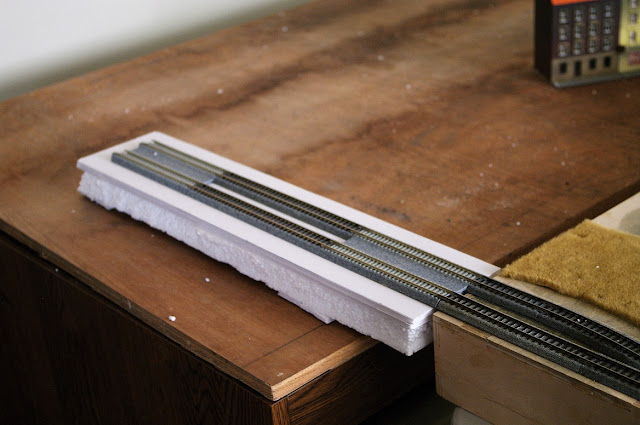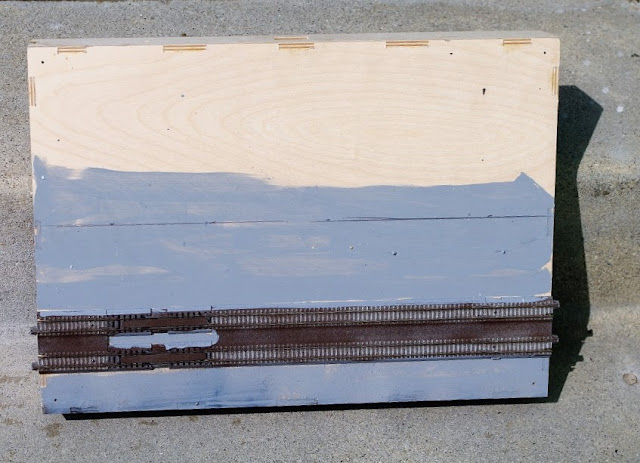The lights are off in the photo above, on in the photo below. If nothing else, this alone is a good feature!
I made a temporary staging "module" to connect to one of the end T-Trak modules from scrap material and surplus Unitrack. When I moved the T-Trak modules to a new 6 foot by 30 inch folding table, this left the old computer desk on which I originally assembled the modules free. The temporary stage will give me some ideas on how to operate the layout and expand it to a version 3.0 with a new module on the computer desk in the indefinite future. The stage can just about handle a 3-car Amfleet train with a P42. This could be an abbreviated Illinois or Michigan service train, or a full-length Boston section of the Lake Shore. Given the overall size of the layout, I'm likely to stick with passenger and commuter service with some limited local freight operation.Sunday, October 28, 2018
More T-Trak Progress
Tuesday, October 23, 2018
P.C.C.M #51 C
Sunday, October 21, 2018
Walthers Citirail ES44AC, ESU vs Soundtraxx, Ditch Lights
According to The Diesel Shop, CitiCorp Railmark has 100 ES44ACs numbered 1201-1215, delivered 2012, 1301-1350, delivered 2013, and 1401-1435, delivered 2014. A further 25 units, 1501-1525, delivered 2015, are listed as "Tier 4 Credit Units". While this isn't intended as a detailed review, several guys have talked about them on YouTube and say the details, including the number of dynamic brake vents and position of the front cab door, are correct for these units, although the front handrails are not.
I don't intend to superdetail my unit, but I do like to see PTC antennas on my models, so I was curious about what type these locos have. However, a search of photos on the web didn't turn up any photos of cab roofs that showed PTC antennas, which most recent locos in main line service on Class 1s now have. I posted a question about this on a forum and learned that these locos are not equipped with PTC, which means they cannot run in the lead in a consist on lines that are PTC equipped.
Thus, although BNSF uses them, they don't run in the lead on BNSF main lines. Also, they run on the Valley Line in California and on the Transcon, but they don't run between Barstow and Los Angeles, where a more limited number of locos in a captive pool tend to be used. Here's another one I caught at a crossing in Bakersfield not too long ago:
You can see that, although no PTC antenna is visible, the loco does have an older style white GPS dome on the cab roof. I will add this when I can find the right part. These locos do run in the lead on routes that either do not have PTC or have the requirement waived. YouTube videos show that when in the lead, they do not have flashing ditch lights when the horn is blown, which is the rule for UP and BNSF. Also, a YouTube video comment says these have Nathan K5HLL horns. The ESU sound decoder gives this as an option, but it is not the default. For Nathan K5HLL, you can set CV 163=1.I hear a lot of complaints on YouTube about the brightness of the Walthers ditch lights. When I compare them to the ditch lights on other brands, though, I frankly don't see that much difference. For instance, here is a Walthers ES44C4 on the left, with a ScaleTrains ET44C4 on the right. I am using BNSF units for both to avoid any distortion that might result from different paint schemes.
Compare this to a prototype view: I think that for all situations but head-on, this is acceptable. If the loco is coming at you head-on, they are in fact brighter on the prototype, but I haven't yet seen a model that's that bright.In this run of ES44ACs, Walthers changed from a limited-range SoundTraxx sound decoder to a limited-range ESU decoder. Judging from the reaction on YouTube, most guys prefer the ESU, and I agree. In addition, the ESU provides much better control of the loco, it starts very, very slowly at DCC speed step 1 without any need to tweak CV 2. Judging from my experience with ESU decoders on ScaleTrains locos, this is a standard feature of ESU. I think it adds value to the Walthers drive.
Monday, October 15, 2018
The NCE Illuminator With Woodland Scenics Just Plug
One new feature of DCC is the ability to use a new product, the NCE Illuminator, to control and power the Woodland Scenics Just Plug lighting system via the DCC power bus. The full Woodland Scenics Just Plug system requires a separate power supply, a separate wiring circuit, and separate control hardware. This is a lot of extra work, especially if you have to crawl under the layout to install and maintain it.
Running a version of the Just Plug system off the DCC power bus makes things much easier. In addition, the Just Plug system by itself allows individual LEDs to have brightness adjusted via the Light Hub. Individual strings of LEDs can be turned on and off via the Auxiliary Switch. However, these are both hardware products, and on medium or large layouts, you have some complexity having to go to individual Auxiliary Switches to turn individual strings on and off.
The NCE Illuminator offers a great deal of extra flexibility. Individual Illuminator decoders can be switched on and off by addressing them as "locomotive decoders" on the command station and using F0. No need to walk around the layout to do it. Beyond that, each individual port/LED combination can be configured via CVs on each individual Illuminator. These features include:
- Steady on and brightness while on
- Slow flashing
- Fluorescent flicker A, more on than off
- Fluorescent flicker B, more off than on
- Fluorescent flicker C, a definitely dying fluorescent tube
- Random on/off (times from 4 seconds to 1 minute)
- Random on/off (times from 4 seconds to 2 minutes)
- Random on/off (times from 8 seconds to 4 minutes)
- Mercury vapor street light coming on (takes about 30 seconds to full brightness)
- Rapid flash.
I started with two Illuminators to try things out. Here's my first installation, on a plain vanilla T-Trak module;
This again is my standard practice, with a terminal strip on each module connecting each individual track and each DCC decoder to the DCC bus/track bus. The Just Plug ports on the Illuminator shown can be used to connect any Just Plug LED or other Just Plug accessory like a building with lights or a street light, and each one can be programmed for any of the lighting features listed above.My practice with T-Trak modules is to include documentation on the underside of each module, as shown here. This will record what CVs have been set on each port.
Here is the top of this module. It will be used for a Kato N North American Station kit. This and other town buildings will have lights that come off Illuminators. I will probably install at least one more Illuminator on this module.
Here is an LED connected to the other Illuminator I got for evaluation on another module. This goes inside an N Scale Architect PRR Harris Tower kit:
The cost to set up very basic layout lighting with the pure Woodland Scenics system, based on the current prices at MB Klein, would be Power Supply $14.99; Light Hub $12.99; and two pair of LED Stick-on Lights @ $7.49, or $14.98, for a total of $42.96. Divided by 4, this gives a cost of $10.74 per individual light.To expand the system beyond four ports requires an expansion hub at $11.99, and if you want to control the on-off for individual strings of lights, an auxiliary switch at $7.49. So if you wanted to have a total 8 lights, your additional cost would be $11.99 plus $7.49 plus another two pair of stick-on LEDs at $14.98, or $34.46.
Adding the additional cost of $34.46 to the basic cost of $42.96 gives $77.42. Divided by 8, this gives an average cost per light of $9.68.
An individual NCE Illuminator at MB Klein is $13.59. A single Illuminator has 3 ports. To even out the cost comparison, let's take two Illuminators at $27.18 and three pair of stick-on LEDs for $22.47 This comes to $49.65 for six lights, or $8.27 per light. So the average cost of using the Just Plug components with an NCE Illuminator is slightly lower per port than using the full Just Plug system, but there are the advantages of operating the lighting system off the DCC bus without the need for a separate wiring circuit with additional control hardware, the ability to control the lighting functions from the DCC control station, and the additional function features available from the Illuminator.
So for those on DCC, the NCE Illuminator is a cost-effective and flexible way to add additional lighting features with minimum extra complexity.
Monday, October 8, 2018
P.C.C.M 50J -- I Catch A D&H Westbound
I caught an Empire Belt hopper in the train: And a real find, a Susquehanna boxcar: Here's the train passing West Zenith: And entering the tunnel at Rattlesnake Rocks. where we saw the last of UP Extra 53 last week:














































